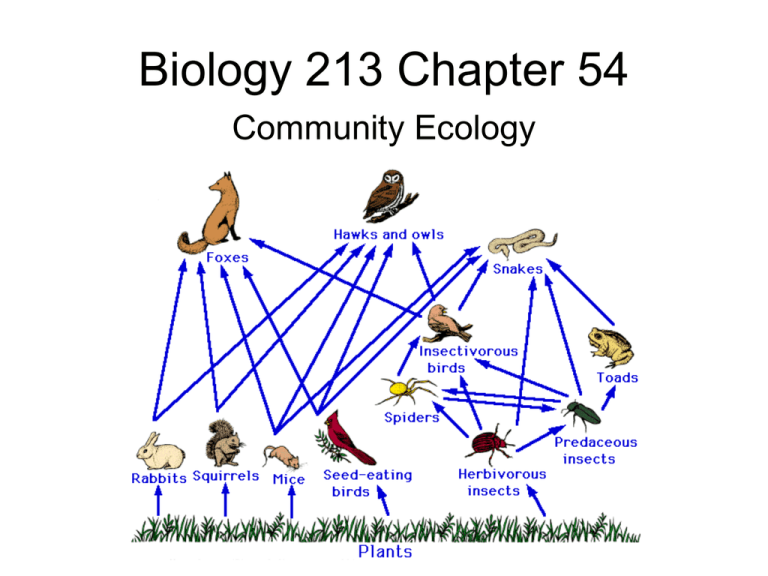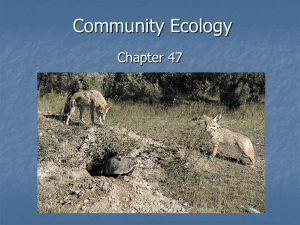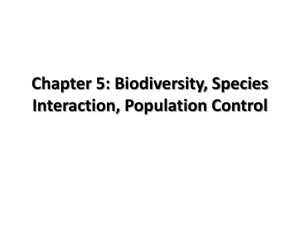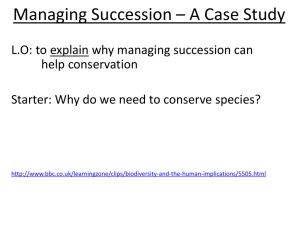Communities - Rogue Community College
advertisement

Biology 213 Chapter 54 Community Ecology Please turn in any Bird books Tree I.D. books Stopwatches Or any field trip items that you forgot to turn in already. Keep your science fees to zero, Thank you. You will be able to… • Define and give examples of niches • Describe various types of interactions within a community • Compare & contrast how dominant and keystone species influence a community Dining In • Wasps and Pieris caterpillars form an unusual three-step food chain • The 4-mm-long wasp Apanteles glomeratus stabs thru skin of Pieris rapae caterpillar & lays her eggs • caterpillar is destroyed when wasp larvae hatch & nourish themselves on its internal organs • Ichneumon wasps can detect when a Pieris caterpillar contains Apanteles larvae Female ichneumon will pierce caterpillar and deposit her own eggs inside of Apanteles larvae • Finally, another wasp, a chalcid, may lay its eggs inside the ichneumon larvae • Usually, only the chalcids will emerge from the dead husk of the caterpillar • Biological community interactions & interdependence of organisms living in it. • Ecosystem functioning depends on complex interactions btwn its community of organisms and the physical environment A community = all organisms inhabiting a particular area • Several factors characterize every community – Biodiversity – Prevalent form of vegetation (& its levels) – Response to disturbances – Trophic structure (feeding relationships) Biodiversity = variety of different kinds of organisms that make up a community two major components: 1. Species richness, or total # of different species in the community 2. Relative abundance of different species Interspecific interactions: (+), (-), neutral • Competition (-)/(-) occurs btwn 2 populations if they both require same limited resource Interspecific interactions: (+), (-), neutral • Predation (+)/(-) one species kills & eats other species Symbiosis • A symbiotic relationship is an interaction between two or more species that live together in direct contact • 3 main types of symbiotic relationships within communities • Symbiosis 1. Mutualism • Both partners benefit 2. Commensalism • One partner benefits and the other is unaffected 3. Parasitism • One partner benefits while the other is harmed Interspecific interactions: (+), (-), neutral • Parasitism (+)/(-) one species is nourished by another species; harms other species. • Parasitism: type of predator-prey relationship – parasite benefits and host is harmed – parasite obtains food at expense of host – Parasites are typically smaller than their hosts Worldwide, 25% of all deaths result from parasite infections Interspecific interactions: (+), (-), neutral • Mutualism (+)/(+) both species benefit • Examples of mutualism –Nitrogen-fixing bacteria and legumes Mutualism can be • Obligate: one species cannot survive without the other • Facultative: both species can survive alone Mutualism: Algae in coral polyps give C and N compounds, get N in return (NH3) from coral waste. Obligate or Facultative? Pollination is mutualism: e.g. Milkweed (Asclepias) is pollinated by butterflies mutualism often demonstrates coevolution Each party evolves features that take advantage of the association, but also provides them with an encouraging reward. Interspecific interactions: (+), (-), neutral • Commensalism (+)/(0) only 1 species benefits; other species is not harmed • Commensalism - symbiotic relationship where one partner benefits and other is unaffected • e.g. of commensalism –Algae growing on shells of sea turtles –Barnacles that attach to whales –Birds that feed on insects flushed out of grass by grazing cattle Commensalism Spanish “moss” and southern trees (e.g. Golden Larch) One benefits, the other isn’t helped or harmed Competitive exclusion principle Populations of 2 species cannot co-exist in a community if their niches are nearly identical Resource partitioning or character displacement occurs (or extinction of one species) High tide Chthamalus Balanus Ocean Low tide • Competition btwn species with identical niches has two possible outcomes 1. One population survives: • more efficient using resources • reproductive advantage, • may eventually eliminate other (difficult to observe). 2. resource partitioning • Ecological niche – Distinctive lifestyle & role of an organism in a community – all abiotic and biotic aspects – E.g. organism’s habitat is one parameter used to describe the niche Various community niches interact: How does a bumper crop of acorns relate to a human disease? Increase in human exposure to Lyme bacterium Public health hazard Deer attracted to forest Tick population increases Healthier forest Oaks thrive; bumper crop of acorns White-footed Mouse population increase Decrease in gypsy moth pupae • Fundamental niche –Potential ecological niche for an organism • Realized niche –Niche an organism actually occupies • Limiting factors –Environmental resources and components that restrict an organism to a realized niche Competition effect on organism’s realized niche Brown anole: introduced species Out-competes native green anole where 2 niches overlap Fig. 54-3a EXPERIMENT Chthamalus Balanus High tide Chthamalus realized niche Balanus realized niche Ocean Low tide Fig. 54-3b RESULTS In terms of their niches, what do the results tell you about Chthamalus? And about Balanus? Ocean High tide Chthamalus fundamental niche Low tide • Competition –Two or more individuals attempting to use same resource –Intraspecific competition • Among individuals within a population –Interspecific competition • Between different species Interspecific competition between protists Grown together: P. aurelai excludes P. caudatum • Some species reduce competition by resource partitioning • Competition among species is reduced by character displacement: –Structural, ecological, & behavioral characteristics diverge where ranges overlap (sympatric) Spatial Temporal Food Character Displacement Characteristics tend to be divergent in sympatric populations of 2 species than in allopatric populations of same 2 species Fig. 54-4 G. fuliginosa G. fortis Character Displacement Percentages of individuals in each size class Beak depth 60 Los Hermanos 40 G. fuliginosa, allopatric 20 0 60 Daphne 40 G. fortis, allopatric 20 0 60 Sympatric populations Santa María, San Cristóbal 40 More divergent 20 0 8 10 12 Beak depth (mm) 14 16 Resource partitioning Galapagos finches Ancestral finches diverged to partition limited resources: insects, seeds, etc. Character displacement: structural changes occur Resource partitioning: different life stages Agraulis vanillae Adults feed differently from larvae. Different Adult species avoid direct competition: feed on different parts of plants, & select different microhabitats Heliconius charitonius • Predation –Consumption of one species (the prey) by another (the predator) • Coevolution –Predator and prey both evolve more efficient ways to interact. –Prey changes to escape predation –Predator becomes more efficient at predation Coevolution in sea shell studies • Modern shells show scars from molluscivore crab predation • Ancient shells from similar environment show scars too, but crab claws have evolved to be stronger with bigger “teeth” • Shells have evolved more thickness, larger size, rigid calcification, quick scarring, and variations in shape. • As predators adapt to prey, sometimes natural selection also shapes prey's defenses • process of reciprocal adaptation is known as coevolution Eggs – Example: Heliconius & passionflower vine females avoid phony eggs. Sugar deposits Ants & wasps also attracted to sugar deposits & prey upon butterfly’s eggs. • Defenses – Mechanical & chemical defenses – Associating in groups – Cryptic coloration – Aposematic (warning) coloration – Müllerian & Batesian mimicry • Prey gain protection against predators thru variety of defense mechanisms –Mechanical defenses, e.g.quills of a porcupine Associating in groups Chemical defenses – widespread & very effective – Animals with effective chemical defenses often brightly colored to warn predators – e.g.: poison-arrow frog Skunk • Camouflage - very common defense in animal kingdom – Example: gray tree frog Cryptic coloration • Batesian mimicry: when a palatable or harmless species mimics an unpalatable or harmful one – Mimicry can even involve behavior – This hawkmoth larva puffs up its head to mimic the head of a snake These butterflies are not Batesian mimicry but are Müllerian mimicry • Müllerian mimicry: 2 unpalatable species that inhabit same community mimic each other – Example: cuckoo bee and yellow jacket Predation can maintain diversity in a community • keystone species exerts strong control on community structure due to its ecological role • A keystone predator may maintain community diversity by reducing #’s of strongest competitors in a community – e.g. sea star is a keystone predator • Seals over-hunted – normal food for Orcas • Predation by Orcas (Killer whales) on sea otters, allowing sea urchins to overgraze on kelp – Sea otters represent the keystone species Fig. 54-16 Otter number (% max. count) 100 80 60 40 20 0 (a) Sea otter abundance Grams per 0.25 m2 400 300 200 100 Number per 0.25 m2 0 (b) Sea urchin biomass 10 8 6 4 2 0 1972 1985 (c) Total kelp density 1989 Year 1993 1997 Food chain • Keystone species – Present in small numbers but are crucial in determining species composition and ecosystem functioning • Dominant species – Affect the community because they are so commonly found – Largest biomass Dominant species • One hypothesis: dominant species most competitive in exploiting resources • Another hypothesis: dominant species most successful at avoiding predators • Invasive species, introduced to a new environment by humans, often lack predators or disease. – What are some invasive species in our region? Foundation Species (Ecosystem “Engineers”) • ecosystem “engineers” cause physical D’s in environment affecting community structure Biology 213 Chapter 54 Community Ecology Part 2 You will be able to… • Compare and contrast various types of symbiosis • Explain the concept of biodiversity and its importance in studying ecosystems. • Compare & contrast 1o & 2o succession • Explain types of “disturbances” (man-made & natural ) that can cause succession. Biodiversity • Ecological measurement of an ecosystem’s “health” • Measures interactions within a community and interdependence of various species. • Describes a community’s ability to survive various types and degrees of disturbance • Species richness –# of species within a community • Species diversity –Relative importance of each species within a community Effect of community complexity on species richness Complexity of chaparral communities based upon density and height of foliage. Higher complexity is reflected in larger # & variety of bird species: more variety in food and shelter. Reflects drier habitat in Chile. Species richness • Related to solar E & H2O (autotrophs) • Evolutionary history & age of an area • Related to isolation – “islands,” mountain tops – replacements vs extinction Fig. 54-27 Equilibrium number Number of species on island (a) Immigration and extinction rates Rate of immigration or extinction Rate of immigration or extinction Rate of immigration or extinction “Islands” can be any isolated region Small island Large island Number of species on island (b) Effect of island size Far island Near island Number of species on island (c) Effect of distance from mainland Species richness • One major dominant species reduces richness (think city fauna) • Community margins overlapping – Ecotones or Edge Zones – Enrich a community’s diversity Edge Zones = Ecotones Species richness = stability • Older, moderately disturbed communities often richer in species – Glaciated regions vs rain forests • Less diverse habitats more prone to devastation by one event or agent – Planted field vs diverse “natural” field responding to pests Older moderately disturbed communities richer in species Frequently or recently disturbed area shows less diversity in some cases. But is that always true? • Intermediate disturbance hypothesis –Disturbance affects succession and species richness –Species richness is greatest at moderate levels of disturbance Intermediate disturbance hypothesis The nature of communities – Organismic model • Views a community as a “super-organism” that goes through stages of development (succession) The nature of communities – Individualistic model • Abiotic environmental factors are primary determinants of species composition • Organisms are separate from each other; communities can rearrange independently of each species • Ecological succession –Primary succession • Occurs in an area not previously inhabited –Secondary succession • Occurs where there is a preexisting community and well-formed soil • Ecological succession is a transition in species composition of a community following a disturbance – Primary succession is gradual colonization of barren rocks, gravel, or sand by living organisms – Secondary succession occurs after a disturbance has removed vegetation but left soil intact Primary succession Starts without soil. No organic matter, only mineral material: sand, bare rock, gravel from glacial outwash, volcanic ash lava, man-made structures or severe erosion Primary succession Volcanic regions: Pioneer plants must establish themselves in tiny crevices that collect some moisture and infinitesimal bits of organic detritus Secondary succession Starts with soil. Pioneer plants start from roots or seeds in soil or transported seeds (by wind or animals) from surrounding areas. Faster than primary succession. Some regions are periodically “disturbed” by natural phenomena • Floods • Blizzards & avalances • Hurricanes Are these “disturbances” actually part of the area’s ecosystem? What happens when these disturbances are eliminated? e.g. flooding on damned rivers / fires in our region? Some regions are periodically “disturbed” by man-made phenomena • Logging • Agriculture – land clearing, pests “encouraged” • Alien species introduced accidentally & purposefully • Grazing • Building How do communities react to disturbances? How can humans minimize impact on local communities? Succession study: Abandoned Field to Oak Forest • Dwight Billings in 1930s • Succession of plant species on abandoned agricultural fields in N. Carolina. • Deserted from a few years to ~ 150 years. First stage of secondary succession • Pioneer plants – Annual species & lichens – Colonize bare ground and nutrient poor soils Second stage • Annuals quickly replaced in dominance the next year by biennial plants and grasses • Two year life cycle • Usually reproduce in 2nd year Perennials and Shrub stage • After about 3 to 4 years: – biennial & grass species gave way to perennial herbs and shrubs • Perennial plants – live for many years – reproduce several times over their life spans. Softwood tree species take over • After about 5 to 15 years: – Loblolly, Shortleaf, and Virginia pines & Sweet Gum trees colonize the area (Note: S.E. U.S.) Softwood tree species take over • Forest canopy starts to form – canopy reduces light reaching forest floor – shaded understory excludes light loving perennial herb and shrub species – low light perennial herb and shrub species take over ground cover Canopy changes habitat • Canopy changed microclimate of habitat near ground level. – more humid – moderated temps – less wind – rain drops cushioned Canopy changes habitat • Low light conditions inhibited germination of pine seedlings. • Development of a soil litter layer & humus • Soil chemistry changes Forest composition changes slowly • Shade, humidity, humus and leaf litter, low light – germination of hardwood species: • oak (Quercus spp.) • hickory (Carya spp). • 50 to 75 years after pioneer species hardwoods start to replace softwood species – pines max heights ~ 25 meters – oaks & hickories average ~ 10 meters tall Climax Community • Softwoods: shorter life span ~ 50 yrs • Gap created filled by subdominant hardwood trees • Oak and hickory, can live for more than 100 years • Sites more than 100 years old were found to be dominated by mature oak forests This succession takes ~ 120 yrs from pioneer stage to climax community. • With infrequent disturbance: a stable climax community consisting of plants and animals that can reproduce themselves in the existing conditions will become established. • Disturbance of the ecosystem will start the process of succession anew. Remember: succession isn’t usually uniform • In one area - usually small patches in different stages of succession • Depends on time & severity of last disturbance • Adds diversity in types of vegetation and animals living in the greater region. Agriculture, overgrazing, and logging affect a region’s succession Fig. 54-24 Disturbance of ocean floor by trawling: removes ~ 5 to 25% of an area's seabed life on a single run. The role of fire in ecosystems –key abiotic factor in many ecosystems –Grasslands so dependent on fire its absence is considered a disturbance –Allelopathic chemicals burnt off –Accumulated debris reduced and nutrients released Fire Ecology 1. Fire Dependence: effects of fire make environment more hospitable for regeneration & growth. 2. Fire History: fire frequency occur in an area. – Record: fire scars or charcoal layer in tree rings 3. Fire Regime (characteristics): intensity, severity, frequency, and vegetative community. Fire Ecology 4. Fire Adaptation: special traits to survive fires at various stages of plant life cycles: • serotinous cones • fire resistant bark • fire resistant foliage • rapid growth and development Fire maintains ecotones: small fires create many “edges” Clicker Question #2 on succession: A small fire burns through a Douglas-fir old growth forest. What type of succession would occur on the forest floor, and what would the dominant plant species be several months after the fire? A. 2o succession; mature Douglas-fir trees B. 1o succession; grasses C. 2o succession; oak and madrone trees D. 1o succession; mosses & lichens E. 2o succession; grasses Rogue valley succession Depends upon: Climate Local physical factors Slope – what does that do? * Water run-off; angle & direction of sun Altitude Fires, storms, & floods Rogue valley succession Depends upon: Communities • Composition of plants: type, age, & distribution • Animals – grazing, soil compaction/fertilization, others? Rogue valley succession Depends upon: Human activities: • Alien plant & animal species introduced • Logging, agriculture, grazing, building houses & roads • Fire suppression Successional stages in our area: • • • • • • Grasses White oak savanna Chaparral Black oak and Madrone Ponderosa pine (may be mixed) Douglas-fir and other trees (e.g. Incense cedar)








